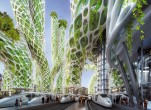Cities of the Future: World Experience and Perspectives

The image of the city of the future always ignites fantasy and imagination of not only professional urban planners, but also of an ordinary person. Everyone is interested to see an ideal place where they will lead a brighter and more interesting life than in the existing reality. Something secret and unexplored in the architecture of the designed anthropogenic space usually has positive character, as people tend to form a comfortable and permanently improving environment around them. The level of comfort increases and the essence of the aesthetics reflects the existing professional artistic concepts. Given the fact that according to the UN, 55% of the world’s population (more than seven billion people) currently live in cities, and by the middle of the century this figure will increase by at least 10-12%, the study of futurological concepts of urban development that occupies specialists’ minds seems to be a very important and urgent task.
At different periods, a desire to look beyond the horizon of time and see the future seemed an alluring and inspiring task to mankind. The architect’s daily work required implementation of the images of this obscure, and infinitely attractive future at all times. The architect puts the elements of ideas about the future in certain spatial shapes, the urban planner forms the scale of the newly created urban environment, and the urbanist connects the general concepts of the city development as a system with current demands of the society. All of them develop mechanisms of transition from abstract futuristic ideas to methods of city functioning as the dominating habitat of mankind in the modern world.
It is possible to visualize images of the city of the future by getting together a mosaic of certain previously unseen buildings. It is possible to offer other transport systems and means of communication in urban environment. Finally, it is possible to implement fundamentally new models of life in the city, and the usual urban environment should be radically modified to suit them. In modern society, the future of cities is arranged, to a variable degree, based on all these principles. What will affect the potential appearance of our cities in the nearest and more remote future most of all? What exactly determines what our cities will look like in 30, 50 and 100 years?
Full content of this issue you can read here
The full version of the article can be read in our printed issue, also you can subscribe to the web-version of the magazine
 Text by Marianna Mayevskaya, Research Associate in the Scientific Research Institute of Theory and History of Architecture and Urban Planning (NIITIAG)
Text by Marianna Mayevskaya, Research Associate in the Scientific Research Institute of Theory and History of Architecture and Urban Planning (NIITIAG)


